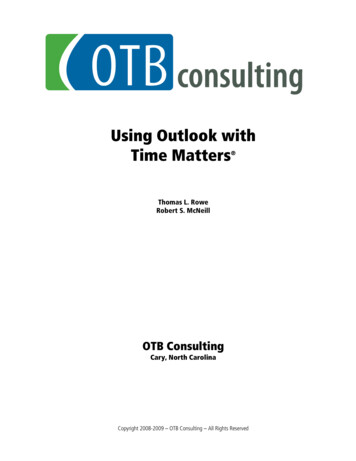
Transcription
OECD Employment Outlook 2018The role of collective bargaining systemsfor good labour market performanceLIVE WEBINAR4 July 201813:00-14:00 CEST (Paris time)7:00-8:00 EDT (Washington DC)
OECD Employment Outlook 2018The role of collective bargaining systemsfor good labour market performanceStéphane Carcillo, Head of the Jobs and Income Division, OECDOliver Denk, Senior Economist, Jobs and Income Division, OECDAndrea Garnero, Economist, Jobs and Income Division, OECD
Join the discussionAsk questions and comment throughout via thewebcast chat function.After today’s event, don’t forget to follow us at:@OECD SocialPublication URL: oe.cd/employment-outlookFor more ivebargaining.htm
Good labour relations can help meet thechallenges of a changing world of work“Improved social dialogue can lead to “win-win-win” situations inwhich more inclusive labour markets and workplaces translateinto better socio-economic outcomes and greater well-being forworkers, better performance for businesses and restored trust ingovernments”Angel Gurría, Secretary General of the OECD
Main messagesDeclining collectivebargaining coverageand decentralisationYet, collectivebargaining can bringmany benefitsBalance betweeninclusiveness andflexibility importantComponents of a good collective bargaining system:Some macroeconomicelement of wageco-ordinationSome decentralisationso that firms canadjust wagesA system that covers alarge share of workersand companies
Collective bargaining under threat?%40Trade union tes201510Employer organisation densityLatest year ( )2000 or closest year604020050Collective bargaining coverage%807060European Union504030OECD20JapanUnited States100
Collective bargaining and labourmarket performanceInclusive growth and well-beingQuality of theworkingenvironmentWages(levels orkingconditionsFlexibility(opt-outs,favourability principle)Level(sector vs. firm)Coverage(unions,employers rdinationResilience &adaptability
A taxonomy of collective bargainingsystemsFive main types of collective bargaining systems:Predominantly centralised and weakly co-ordinatedPredominantly centralised and co-ordinatedOrganised decentralised and co-ordinatedLargely decentralisedFully decentralised
Co-ordinated systems are linked withbetter employment outcomesDifference in percentage points with respect to fully decentralised systemsEmployment rateUnemployment ratep.p.6******4******20*-2***-4Predominantly centralised andweakly co-ordinatedPredominantly centralisedand co-ordinatedOrganised decentralisedand co-ordinatedLargely decentralisedNote: ***, **, *: statistically significant at the 1, 5 and 10% levels, respectively. Results are based on OLS regressions including country and year dummies, collective bargaining coverage, logof average years of education, female employment share and institutional variables: (tax wedge, product market regulation, employment protection legislation (both temporary andpermanent), ratio of minimum wage to median wage and gross unemployment benefit replacement rate). p.p.: percentage points.Source: OECD estimates. Details on sources and definitions can be found in Chapter 3 of the Employment Outlook 2018.Co-ordinated systems are linked with higher employment and lower unemployment,also for young people, women and low-skilled workers than fully decentralised systems
Collective bargaining is linked withlower wage inequalityDifference in percentage points with respect to fully decentralised systemsD9/D1D9/D5D5/D1Point difference in the decile 25******-0.3-0.35***Predominantly centralised andweakly co-ordinatedPredominantly centralisedand co-ordinatedOrganised decentralisedand co-ordinatedLargely decentralisedNote: ***, **, *: statistically significant at the 1, 5 and 10% levels, respectively. Results are based on OLS regressions including country and year dummies, collective bargainingcoverage, log of average years of education, female employment share and institutional variables: tax wedge, product market regulation, employment protection legislation (bothtemporary and permanent), ratio of minimum wage to median wage and gross unemployment benefit replacement rate. Earnings inequality measures are based on gross earningsof full-time wage and salary workers. D1, D5 and D9 stand for the first, fifth and ninth decile of the wage distribution.Source: OECD estimates. Details on sources and definitions can be found in Chapter 3 of the OECD Employment Outlook.Wage dispersion is greater in systems with no collective bargaining or where firms setwages independently (also when using individual-level data)
Wages are higher for workers covered bya firm-level agreementComposition-adjusted difference in average earnings relative to no collective bargaining, 2014A. Sector-level bargaining%20151510105500-5-5-10-10-15Countries with three UXSVKDEUCZEPRTAUSGBRAverageNORCountries withtwo bargainingtypes-20AverageCountries with three bargaining typesNLDAverageLUXCZEGBRDEUAUSSVK-15PRT-20B. Firm-level bargaining%20Countries with two bargaining typesNote: Results are based on Juhn-Murphy-Pierce decompositions using workers without a collective agreement as the reference group and controlling for gender, age groups, educational attainment,industry, occupation, firm size, type of contract and job tenure. Data are from 2012-16, depending on the country (2006 for Germany). “Sector-level bargaining” for Australia refers to the use of ModernAwards (see Box 3.5) in Chapter 3 of the Employment Outlook 2018. A proper sector-level bargaining does not exist in Australia.Source: OECD calculations based on sources described in Chapter 3 of the Employment Outlook 2018.Within countries, there is a wage premium for workers who are covered by firm-levelbargaining compared with those not covered or those covered only by sector-level bargaining
Wages and productivity are less tightlylinked where bargaining is strongerThe extent to which high-productivity sectors pay higher wages than low-productivity sectorsHigh wage co-ordination across sectorsNo or low wage co-ordination across sectorsElasticity of wages with respect to productivity0.50.40.30.20.10In countries where collective bargaining is more important, wages tend to beless responsive to productivity differences.
Employee representation predicts lessjob strainDifference in job strain (or its sub-components) compared with the absence of employee workplace l demandsJob strainWork intensityJob demandsInflexibility ofworking hoursTask discretionTrainingCareeradvancementJob resourcesNote: ***, **, *: statistically significant at the 1, 5 and 10% level, respectively. Results are based on Ordinary Least Squares (OLS) regressions. They control for age,education, gender, type of contract, occupation, job tenure, establishment size, industry and country dummies. p.p.: percentage points.Source: OECD calculations based on the Sixth European Working Conditions Survey 2015.The quality of the working environment, as measured by the OECD/G20 Job QualityFramework, tends to be higher in firms with a recognised form of employee workplacerepresentation (for example a local trade union or works council)
Promoting inclusive and flexiblecollective bargainingMaintaining high coverage. High coverage is best achieved through broad-based social partners Explore new ways to support social dialogue in small firms and for nonstandard forms of employment Extensions, if well-designed to avoid undermining the economicprospects of vulnerable firms and workers, can enhance inclusiveness while leaving some margins of flexibility: Organised decentralisation leaves some flexibility to firms through theuse of framework agreements to be tailored at the firm level or opt-outsWage co-ordination at the central level helps negotiators internalise themacroeconomic effects of collective agreementsSocial partners can contribute to managing job transitions andstrengthening the adaptability of the labour market
Looking forward: which role in thefuture of work?SkillsSocial protectionLabour relationsActivation
THANK D Social@stephancarcillo@AGarnero
OECD Employment Outlook 2018. Stéphane Carcillo, Head of the Jobs and Income Division, OECD Oliver Denk, Senior Economist, Jobs and Income Division, OECD . 5 and 10% levels, respectively. Results are based on OLS regressions including country and year dummies, collective bargaining coverage, log of average years of education, female .










